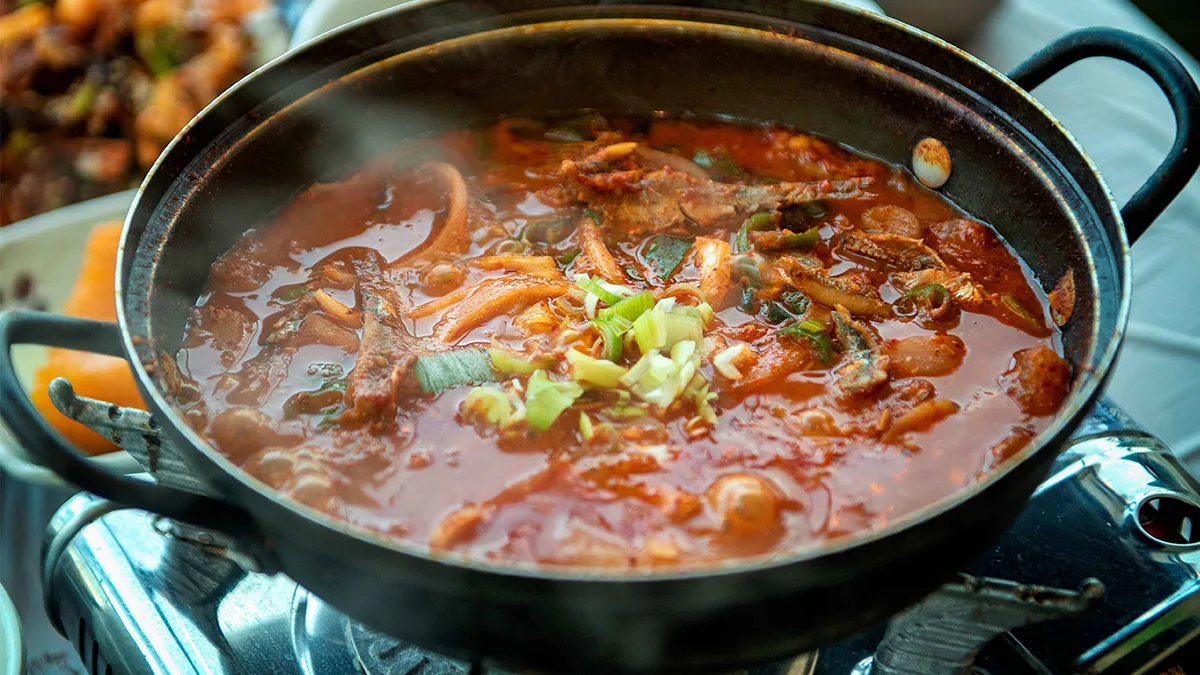Subtotal: 3.65$
Myeolchissambap || Anchovy, Leaf Wraps and Rice, 멸치쌈밥 Leave a comment
Myeolchissambap (멸치쌈밥) is a traditional and flavorful Korean dish that hails from the southern coastal regions of Korea, particularly the Gyeongsangnam-do province, with cities like Tongyeong and Namhae being especially known for it. The name itself is quite descriptive: “myeolchi” (멸치) means anchovies, and “ssambap” (쌈밥) refers to rice wrapped in leafy vegetables.
The core of Myeolchissambap lies in the delightful contrast between the intensely savory and slightly spicy simmered anchovies and the fresh, crisp variety of leafy greens used for wrapping. It’s a dish that truly embodies the Korean concept of “ssam” (쌈), where ingredients are wrapped together to create a balanced and flavorful bite.
How it’s Typically Enjoyed:
To eat Myeolchissambap, you typically take a fresh leaf – this could be anything from lettuce and perilla leaves (kkaennip, 깻잎) to cabbage or even blanched seaweed like kelp (dasima, 다시마). You then place a spoonful of fluffy rice and a generous portion of the simmered anchovies (along with some of the flavorful sauce) in the center of the leaf. Often, people will add a thin slice of raw garlic, a dab of ssamjang (쌈장, a thick, spicy soybean paste), or a sliver of chili pepper for an extra kick. Finally, you fold or wrap the leaf around the fillings and enjoy the explosion of flavors and textures in one satisfying bite!
Myeolchissambap Recipe (General Guide):
While I couldn’t find a specific recipe in my current search results, here’s a general idea of how Myeolchissambap is prepared:
- Prepare the Anchovies: Use dried anchovies specifically meant for broth-making (국물용 멸치). Clean them by removing their heads and any visible innards. This helps to reduce any potential bitterness.
- Make the Seasoning Sauce: In a bowl, combine ingredients for the sauce. This usually includes:
- Korean chili powder (gochugaru, 고춧가루) for spice
- Soy sauce (ganjang, 간장) for savory depth
- Minced garlic (dajin maneul, 다진 마늘) for aroma
- Minced ginger (dajin saenggang, 다진 생강) for a hint of warmth
- Korean soybean paste (doenjang, 된장) for a rich, earthy flavor
- Korean chili paste (gochujang, 고추장) for added spice and sweetness
- Sugar (seoltang, 설탕) or another sweetener to balance the flavors
- Water or anchovy broth to help create the sauce consistency.
- Simmer the Anchovies: In a pot or a shallow pan, place the cleaned anchovies and pour the seasoning sauce over them. Bring it to a simmer over medium heat. Cook until the anchovies are tender and the sauce has reduced and thickened, coating the anchovies nicely. You might need to add a little more water during the cooking process if it becomes too dry. Some recipes might include sliced onions or green onions in this step for added flavor.
- Prepare the Wrapping Vegetables: Wash a variety of leafy vegetables thoroughly. Common choices include:
- Lettuce (sangchu, 상추)
- Perilla leaves (kkaennip, 깻잎)
- Cabbage (yangbae chu, 양배추) – often blanched
- Kelp (dasima, 다시마) – usually blanched
- Other seasonal greens can also be used.
- Cook the Rice: Prepare a pot of freshly cooked, fluffy white rice (bap, 밥).
- Assemble and Enjoy: To eat, take a leaf of your choice, place a spoonful of rice and some of the simmered anchovies (with the sauce) in the middle. You can add a piece of raw garlic, a dollop of ssamjang, or a slice of chili if desired. Wrap it all up and savor the delicious combination!






This image is created using data from the Korea Tourism Organization's Photo Korea, which is open under the Public Domain License. You can download these images for free from phoko.visitkorea.or.kr. (본 이미지는 공공누리 제1유형으로 개방한 ‘한국관광공사 포토코리아'의 데이터를 이용하였으며, 해당 저작물은 ‘phoko.visitkorea.or.kr’에서 무료로 다운받으실 수 있습니다.)
![[Paldo] Bibim Men2 130g x 4 || 팔도 비빔면2](https://i0.wp.com/k-food.market/wp-content/uploads/2025/01/8809695253171.webp?resize=300%2C300&ssl=1) [Paldo] Bibim Men2 130g x 4 || 팔도 비빔면2
[Paldo] Bibim Men2 130g x 4 || 팔도 비빔면2 
![[NONGSHIM] Hooroorook Rice Noodle Chicken Soup 73g x 6 || 농심 후루룩 쌀국수 닭곰탕](https://i0.wp.com/k-food.market/wp-content/uploads/2025/01/8801043053143N06.webp?resize=300%2C300&ssl=1)
![[Paldo] Bibim Men 130g x 5 || 팔도 비빔면](https://i0.wp.com/k-food.market/wp-content/uploads/2025/01/8809695251344.webp?resize=300%2C300&ssl=1)
![[Paldo] Teumsae Ramen Spicy Kimchi Flavor 120g x 4 || 팔도 틈새라면 매운김치](https://i0.wp.com/k-food.market/wp-content/uploads/2025/01/8809695250873.webp?resize=300%2C300&ssl=1)
![[Paldo] Pororo Jjajangmen Cup 65g x 6 || 팔도 뽀로로짜장 컵](https://i0.wp.com/k-food.market/wp-content/uploads/2025/01/8809296882701.webp?resize=300%2C300&ssl=1)
![[Paldo] Teumsae Ramen 120g x 5 || 팔도 틈새라면](https://i0.wp.com/k-food.market/wp-content/uploads/2025/01/8801128508865.webp?resize=300%2C300&ssl=1)
![[Paldo] Ilpum Seafood Noodle Soup 115g x 5 || 팔도 일품 해물라면](https://i0.wp.com/k-food.market/wp-content/uploads/2025/01/8801128503693.webp?resize=300%2C300&ssl=1)
![[Paldo] Bibim Men Cup 115g x 4 || 팔도 비빔면컵](https://i0.wp.com/k-food.market/wp-content/uploads/2025/01/8801128503594.webp?resize=300%2C300&ssl=1)
![[NONGSHIM] Shrimp Crackers Mini Pack (30g x 4) || 농심 새우깡 미니팩 (30g x 4)](https://i0.wp.com/k-food.market/wp-content/uploads/2025/01/8801043026468.webp?resize=300%2C300&ssl=1)
![[NONGSHIM] Shrimp Crackers 90g || 농심 새우깡](https://i0.wp.com/k-food.market/wp-content/uploads/2025/01/8801043035989.webp?resize=300%2C300&ssl=1)
![[NONGSHIM] Sichuan Chapagetti All-Purpose Sauce 280g || 농심 사천짜파게티 만능소스](https://i0.wp.com/k-food.market/wp-content/uploads/2025/01/8801043011006.webp?resize=300%2C300&ssl=1)
![[NONGSHIM] Chapagetti All-Purpose Sauce 280g || 농심 짜파게티 만능소스](https://i0.wp.com/k-food.market/wp-content/uploads/2025/01/8801043069083.webp?resize=300%2C300&ssl=1)
![[NONGSHIM] Bae Hong Dong All-Purpose Sauce 300g || Spicy Pear & Gochujang Sauce, 농심 배홍동 만능소스](https://i0.wp.com/k-food.market/wp-content/uploads/2025/01/8801043062008.webp?resize=300%2C300&ssl=1)
![[NONGSHIM] Muktae Spicy Mayo All-Purpose Sauce 250g || Spicy Mayo All-Purpose Sauce with Dried Pollack, 먹태청양마요 만능소스](https://i0.wp.com/k-food.market/wp-content/uploads/2025/01/8801043011174.webp?resize=300%2C300&ssl=1)
![[NONGSHIM] Hooroorook Kalguksoo 97g x 32 || 농심 후루룩 칼국수](https://i0.wp.com/k-food.market/wp-content/uploads/2025/01/8801043016735N01.webp?resize=300%2C300&ssl=1)
![[NONGSHIM] Hooroorook Rice Noodle Seaweed Soup 74g x 12 || 농심 후루룩 쌀국수 미역국](https://i0.wp.com/k-food.market/wp-content/uploads/2025/01/8801043065429.webp?resize=300%2C300&ssl=1)
![[NONGSHIM] Hooroorook Rice Noodle Beef Soup 73g x 12 || 농심 후루룩 쌀국수 소고기장국](https://i0.wp.com/k-food.market/wp-content/uploads/2025/01/8801043059930.webp?resize=300%2C300&ssl=1)
![[NONGSHIM] Hooroorook Rice Noodle Chicken Soup 73g x 12 || 농심 후루룩 쌀국수 닭곰탕](https://i0.wp.com/k-food.market/wp-content/uploads/2025/01/8801043053143.webp?resize=300%2C300&ssl=1)
![[NONGSHIM] Hooroorook Rice Noodle Beef Soup 73g x 6 || 농심 후루룩 쌀국수 소고기장국](https://i0.wp.com/k-food.market/wp-content/uploads/2025/01/8801043059923.webp?resize=300%2C300&ssl=1)
![[NONGSHIM] Hooroorook Rice Noodle Seaweed Soup 74g x 6 || 농심 후루룩 쌀국수 미역국](https://i0.wp.com/k-food.market/wp-content/uploads/2025/01/8801043065443.webp?resize=300%2C300&ssl=1)
![[NONGSHIM] Hooroorook Noodle 92g x 4 || 農心 呼噜噜面, 농심 후루룩 국수 92g](https://i0.wp.com/k-food.market/wp-content/uploads/2025/01/8801043042994.webp?resize=300%2C300&ssl=1)
![[NONGSHIM] Ansungtangmyun 112g x 5 (Seafood) || 농심 해물안성탕면](https://i0.wp.com/k-food.market/wp-content/uploads/2025/01/8801043043939.webp?resize=300%2C300&ssl=1)



















































